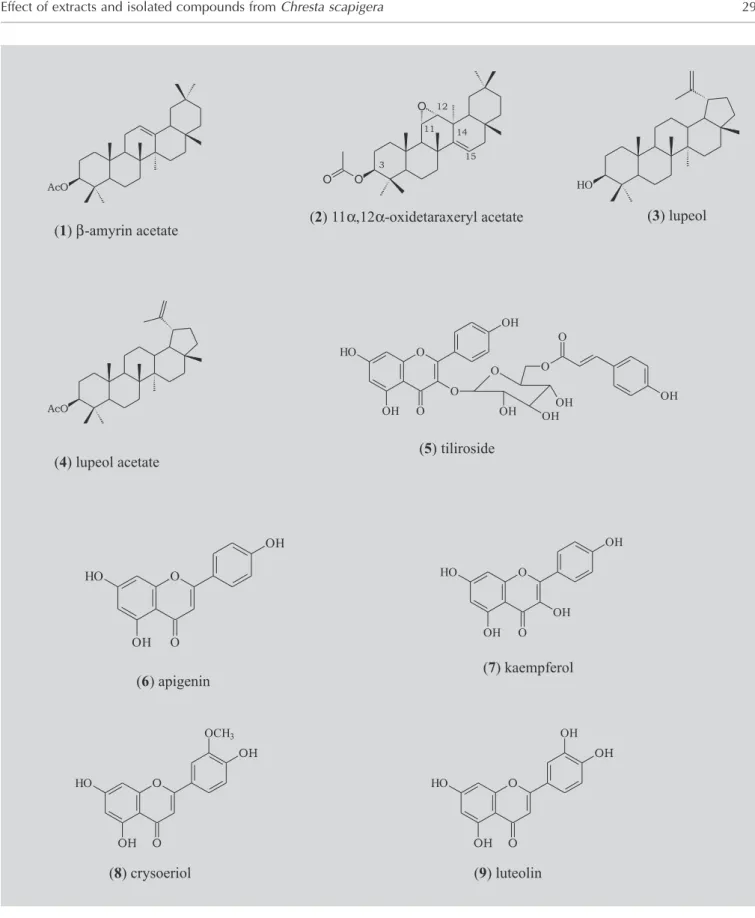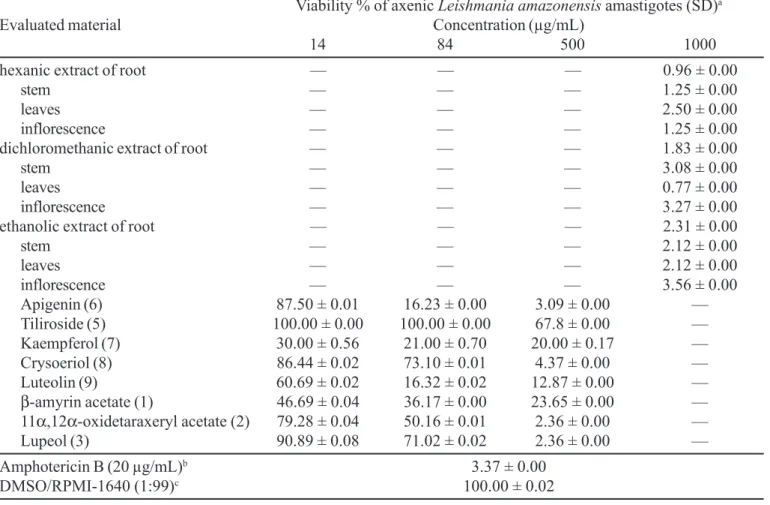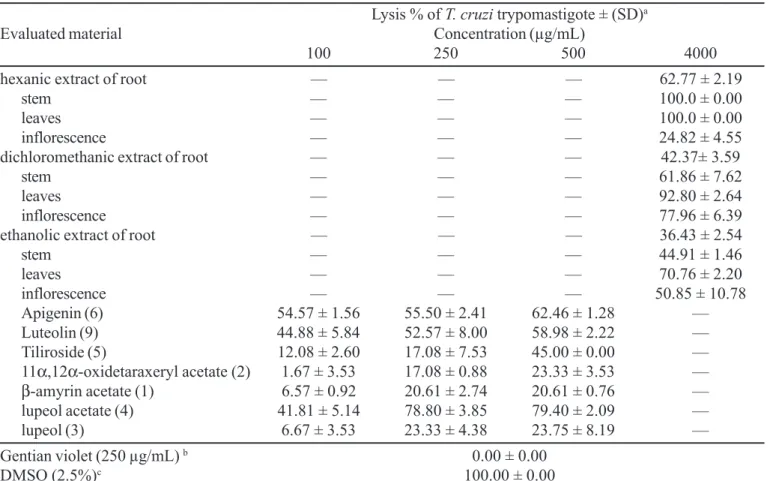vol. 43, n. 2, abr./jun., 2007
Effect of extracts and isolated compounds from
Chresta scapigera
on
viability of
Leishmania amazonensis
and
Trypanosoma cruzi
Elisandra Cristina Schinor
1*, Marcos José Salvador
2,5, Elisabeth Mieko Furusho Pral
3, Silvia Celina
Alfieri
3, Sérgio Albuquerque
4, Diones Aparecida Dias
1,51Departamento de Química da Faculdade de Filosofia, Ciências e Letras de Ribeirão Preto, Universidade de São
Paulo, 2Universidade do Vale do Paraíba, Instituto de Pesquisa e Desenvolvimento, 3Departamento de Parasitologia
do Instituto de Ciências Biomédicas, Universidade de São Paulo, 4Departamento de Análises Clínicas, Toxicológicas
e Bromatológicas da Faculdade de Ciências Farmacêuticas de Ribeirão Preto, Universidade de São Paulo,
5Departamento de Física e Química da Faculdade de Ciências Farmacêuticas de Ribeirão Preto,
Universidade de São Paulo
Fractionation of bioactive crude extracts of Chresta scapigera led to the isolation of four triterpenes and five flavonoids, among them
β-amyrin acetate (1), 11α,12α-oxidetaraxeryl acetate (2) and lupeol (3), as well as the flavonoids apigenin (6), kaempferol (7), crysoeriol (8) and luteolin (9) were active against Leishmania amazonensis amastigotes-like stages, while only the flavonoids (6), (7) and (9) showed toxicity towards bloods trypomastigote forms of Trypanosoma cruzi.
*Correspondence: E. C. Schinor
Departamento de Física e Química Faculdade de Ciências Farmacêuticas de Ribeirão Preto
Universidade de São Paulo Av. do Café, s/n
14040-903 - Ribeirão Preto - SP, Brasil E-mail: ec.schinor@uol.com.br
Uniterms
• Chresta scapigera/
• trypanocidal activity • Flavonoids • Triterpenes • Chresta scapigera/
• leishmanicidal activity
INTRODUCTION
Plants have been traditionally used for the treatment of diseases of different aethiology. Especially in the last decade, phytotherapy has received considerable attention in the search for alternatives to chemotherapy in parasitic diseases control (Muelas-Serrano et al., 2000). Many of these studies involve species of the Asteraceae family,
among which can be mentioned Lychnophora
granmongolense (Grael et al., 2000), Munnozia maronii
(Fournet et al., 1993), Vernonia brachycalyx (Oketch-Rabah et al., 1998), Neurolaena lobata (Berger et al., 2001), whose crude extracts and isolated compounds presented antiprotozoal activity.
Leishmaniasis is a protozoan disease and occurs widely in tropical areas in South America (Sauvain et al., 1996). According to the WHO there are 2 million new ca-ses of leishmaniasis per year worldwide (Barata et al.,
2000). This disease is caused by haemoflagellate protozoan parasites that survive and multiply in magrophages in the mammalian host and are transmitted by phlebotomine sandflies (Salvador et al., 2002). The incidence of the disease has increased in the last years, and the therapy available mainly relies on antimonials, pentamidine and amphotericin B, which are toxic, difficult to apply in the field and not always effective (Mafezoli et al., 2000).
E. C. Schinor, M. J. Salvador, E. M. Furusho, S. C. Alfieri, S. Albuquerque, D. A. Dias 296
clinicians or patients because of its undesirable effects such as coloring the skin and possible mutagenic effects (Grael
et al., 2000; Coura, Castro, 2002). For the acute and chronic diseases, the treatment is still a challenge today, since the available drugs possess severe side effects and are not completely efficient (Coura, Castro, 2002).
Thus, there is an urgent need for new drugs active against Leishmania spp and Trypanosoma cruzi.
Chresta, belonging to Asteraceae family, is a small genus that comprises 12 endemic species of the “Cerrado brasileiro” (Robinson, 1999). There are no prior studies about biological activity of this genus. The present studies, crude extracts (roots, stem, leaves and inflorescences) and some compounds isolated from Chresta scapigera were evaluated for their ability to reduce viability of axenic
Leishmania amazonensis amastigotes and T. cruzi
trypomastigotes forms, in vitro.
MATERIAL AND METHODS
Plant material
Chresta scapigera was collected in Furnas (MG-Brazil) in July, 1998, and identified by Dr. João Semir (Ins-tituto de Biologia, Unicamp, Campinas, SP-Brazil). A voucher of each specimen is deposited in the Herbarium of FFCLRP/USP (SPFR6874).
Extraction and isolation process
Roots (188.0 g), stem (252.0 g), leaves (313.0 g) and inflorescences (99.0 g) were separated, dried, pulverized and stored in dark bags to protect them from humidity and light. The powdered material was extracted by maceration with n-hexane, dichloromethane and ethanol, respectively, at room temperature. The n-hexanic extract of roots (9.521 g) was chromatographed on a column of silica gel 60 (0.063-0.200 mm, Merck), eluted with hexane, ethyl acetate, methanol and mixtures of these solvents of increasing polarity. This extract furnishes 18 fractions and the fractions 3 and 4 were purified by preparative TLC yielding β-amyrin acetate (1) (16 mg) and 11α,12α-oxidetaraxeryl acetate (2) (10 mg), respectively. The n-hexanic extract of inflorescences (2.594 g) was chromatographed in the same conditions and furnishes 14 fractions. Preparative TLC was used to purify the fractions 4 and 7, which yield lupeol (3) (30 mg) and its acetate (4) (6 mg), respectively. The ethanolic crude extract of inflorescence (2.6 g) was partitioned between dichloromethane and methanol. The hidroalcoholic phase (1.3 g) was submitted to filtration on
sephadex LH-20 and the fractions 6 and 7 were purified by preparative HPLC in reverse phase (column ODS Shimadzu 5 µm, 20 x 250 mm, eluent: methanol:water in gradient, flow 9mL/min, UV detection: 280 nm) affording tiliroside (5) (22 mg), apigenin (6) (12 mg) and kaempferol (7) (10 mg), respectively. While the dichloromethanic phase (391 mg) was chromatographed on a silica gel column eluted with hexane, ethyl acetate, methanol and mixtures of these solvents of increasing polarity. The fraction 3 was purified by preparative TLC affording crysoeriol (8) (3 mg). The ethanolic crude extract of stem was chromatographed on PVP by vacuum liquid chromatography eluted with CHCl3, methanol and mixtures of these solvents of increasing polarity. Filtration on sephadex LH-20 was used to purify the fraction 1, which yield crysoeriol (8) (3 mg), apigenin (6) (2 mg) and luteolin (9) (3 mg).
The structures of all compounds were determined by spectroscopic methods (IR, 1H- and 13C-NMR). All extracts and isolated compounds were evaluated against axenic L. amazonensis amastigotes and T. cruzi
trypomastigotes forms, in vitro, according to a previous report (Mafezoli et al., 2000; Bastos et al., 1999).
Trypanocidal activity
For the trypanocidal activity, blood of Swiss albino mice infected with Trypanosoma cruzi (Y strain) was used, which was collected by cardiac puncture at the peak of parasitemia and was diluted to contain 106 trypomastigotes/ mL. Stock solutions (crude extracts) were prepared in 2.5% of dimethyl sulfoxide (DMSO) and were added to blood samples to provide a final concentration of 4000 µg/mL. After incubation for 24 hours at 4 oC, the number of parasites was determined according to Brener (1962). In the tests, gentian violet (250 µg/mL) was used as positive control and DMSO 2.5% as negative control. All experiments were performed in triplicate.
Leishmanicidal activity
FIGURE 1 - Structures of isolated compounds from C. scapigera.
DMSO. Amastigote viability was assessed colorimetrically by reduction of a tetrazolium salt (MTT) as described by Mosmann (1983). Amphotericin B (20 µg/mL) was used as
E. C. Schinor, M. J. Salvador, E. M. Furusho, S. C. Alfieri, S. Albuquerque, D. A. Dias 298
RESULTS AND DISCUSSION
The results are showed in Tables I and II. All the crude extracts evaluated markedly reduce the viability of L. amazonensis amastigotes (at 1000 µg/mL), while only the extracts hexanic of inflorescence, dichloromethanic of root and ethanolic (root and stem) did not interfere appreciably with lysis percentages of T. cruzi trypomastigotes forms (at 4000 µg/mL).
Data in Tables I and II show that effect of the evaluated compounds varies depending on the different concentrations used in the bioassay.
Compound (5) was not active against L. amazonensis
and T. cruzi at the concentrations evaluated, while the compound (1) reduced the viability of L. amazonensis at the lower concentration used (at 14 µg/mL), but not interfere with lysis percentages of T. cruzi trypomastigote forms. Flavonoids (6) and (9) were the most active ones when
assayed at 84 µg/mL against L. amazonensis, but a slight activity was observed against T. cruzi.
Compound (6) presents a 5,7,4’-hydroxylation pattern and showed active since 100 µg/mL with 54% of lysis. Ribeiro et al. (1997) and Grael et al. (2000) have demonstrated that hydroxylated flavonoids were more active than methoxylated flavonoids when evaluated against trypomastigote forms of T. cruzi. The authors believed that the probable mechanism of action for this activity might be explained from drugs that are able to generate reactive oxygen species in which T. cruzi is susceptible.
The other compounds interfered with viability of L. amazonensis and T. cruzi at concentration evaluated.
The results presented can be considered promising and these extracts may represent a source of active substances against mainly amastigote forms of L. amazonensis.
TABELA I - In vitro leishmanial activity of crude extracts and compounds from C. sacpigera against axenic Leishmania amazonensis amastigotes
Viability % of axenic Leishmania amazonensis amastigotes (SD)a
Evaluated material Concentration (µg/mL)
14 84 500 1000
hexanic extract of root — — — 0.96 ± 0.00
stem — — — 1.25 ± 0.00
leaves — — — 2.50 ± 0.00
inflorescence — — — 1.25 ± 0.00
dichloromethanic extract of root — — — 1.83 ± 0.00
stem — — — 3.08 ± 0.00
leaves — — — 0.77 ± 0.00
inflorescence — — — 3.27 ± 0.00
ethanolic extract of root — — — 2.31 ± 0.00
stem — — — 2.12 ± 0.00
leaves — — — 2.12 ± 0.00
inflorescence — — — 3.56 ± 0.00
Apigenin (6) 87.50 ± 0.01 16.23 ± 0.00 3.09 ± 0.00 —
Tiliroside (5) 100.00 ± 0.00 100.00 ± 0.00 67.8 ± 0.00 —
Kaempferol (7) 30.00 ± 0.56 21.00 ± 0.70 20.00 ± 0.17 —
Crysoeriol (8) 86.44 ± 0.02 73.10 ± 0.01 4.37 ± 0.00 —
Luteolin (9) 60.69 ± 0.02 16.32 ± 0.02 12.87 ± 0.00 —
β-amyrin acetate (1) 46.69 ± 0.04 36.17 ± 0.00 23.65 ± 0.00 —
11α,12α-oxidetaraxeryl acetate (2) 79.28 ± 0.04 50.16 ± 0.01 2.36 ± 0.00 —
Lupeol (3) 90.89 ± 0.08 71.02 ± 0.02 2.36 ± 0.00 —
Amphotericin B (20 µg/mL)b 3.37 ± 0.00
DMSO/RPMI-1640 (1:99)c 100.00 ± 0.02
a Parasite viability was determined by the MTT reduction assay; O.D. values are expressed as percent of those of untreated
However, further studies (in vitro and in vivo) should be accomplished in order to understand the mechanisms of action, as well as to evaluate the toxicity, looking for a clinical employment of those bioactive compounds.
ACKNOWLEDGEMENTS
We wish to thank FAPESP for the financial support and Prof. Dr. Walter Vichnewski for the collection of plant material.
RESUMO
Efeito dos extratos e compostos isolados de Chresta scapigera sobre a viabilidade de Leishmania
amazonensis e Trypanosoma cruzi
O fracionamento dos extratos bioativos de Chresta scapigera proporcionou o isolamento de triterpenos e
TABELA II - In vitro trypanocidal activity of crude extracts and isolated compounds from C. scapigera against the trypomastigote forms of Trypanosoma cruzi
Lysis % of T. cruzi trypomastigote ± (SD)a
Evaluated material Concentration (µg/mL)
100 250 500 4000
hexanic extract of root — — — 62.77 ± 2.19
stem — — — 100.0 ± 0.00
leaves — — — 100.0 ± 0.00
inflorescence — — — 24.82 ± 4.55
dichloromethanic extract of root — — — 42.37± 3.59
stem — — — 61.86 ± 7.62
leaves — — — 92.80 ± 2.64
inflorescence — — — 77.96 ± 6.39
ethanolic extract of root — — — 36.43 ± 2.54
stem — — — 44.91 ± 1.46
leaves — — — 70.76 ± 2.20
inflorescence — — — 50.85 ± 10.78
Apigenin (6) 54.57 ± 1.56 55.50 ± 2.41 62.46 ± 1.28 —
Luteolin (9) 44.88 ± 5.84 52.57 ± 8.00 58.98 ± 2.22 —
Tiliroside (5) 12.08 ± 2.60 17.08 ± 7.53 45.00 ± 0.00 —
11α,12α-oxidetaraxeryl acetate (2) 1.67 ± 3.53 17.08 ± 0.88 23.33 ± 3.53 —
β-amyrin acetate (1) 6.57 ± 0.92 20.61 ± 2.74 20.61 ± 0.76 —
lupeol acetate (4) 41.81 ± 5.14 78.80 ± 3.85 79.40 ± 2.09 —
lupeol (3) 6.67 ± 3.53 23.33 ± 4.38 23.75 ± 8.19 —
Gentian violet (250 µg/mL) b 0.00 ± 0.00
DMSO (2.5%)c 100.00 ± 0.00
a Results are expressed as lysis % of T. cruzi trypomastigote forms ± standard deviation (SD); b positive control (IC 50= 31 µg/mL); c mice infected blood containing the same DMSO concentration used in the stocks solution (negative control) did not interfere with parasite viability; —: concentration did not evaluated. All experiments were run in triplicate.
flavonóides, dentre os quais acetato de β-amirina (1), acetate de 11α,12-oxidotaraxeril (2) e lupeol (3), assim como os flavonóides apigenina (6), caenferol (7), crisoeriol (8) e luteolina (9) mostraram-se ativos contra formas amastigotas de Leishmania amazonensis, enquanto, apenas os flavonóides (6), (7) e (9) apresentaram toxicidade con-tra as formas tripomastigotas de Trypanosoma cruzi.
UNITERMOS: Chresta scapigera/atividade tripanocida. Flavonóides. Triterpenos . Chresta scapigera/atividade leishmanicida
REFERENCES
E. C. Schinor, M. J. Salvador, E. M. Furusho, S. C. Alfieri, S. Albuquerque, D. A. Dias 300
BASTOS, J.K.; ALBUQUERQUE, S.; SILVA, M.L.A. Evaluation of the trypanocidal activity of lignans isolated from leaves of Zanthoxylum naranjillo. Planta Med., v. 65, p. 541-544, 1999.
BERGER, I.; PASSREITER, C.M.; CACERE, A.; KUBELKA, W. Antiprotozoal activity of Neurolaena lobata. Phytother. Res., v. 15, p. 327-330, 2001.
BRENER, Z. Therapeutic activity on criterion of cure on mice experimentally infected with Trypanosoma cruzi. Rev. Inst. Med. Trop. São Paulo, v. 4, p. 389-396, 1962.
COURA, J.R.; DE CASTRO, S.L. A critical review on Chagas disease chemotherapy. Mem. Inst. Oswaldo Cruz, v. 97, p. 3-24, 2002.
FOURNET, A.; MUÑOZ, V.; ROBLOT, F.; HOCQUEMILLER, R.; CAVÉ, A.; GANTIER, J.C. Antiprotozoal activity of dehydrozaluzanin C, a sesquiterpene lactone isolated from Munnozia maronii (Asteraceae). Phytother. Res., v. 7, p. 111-115, 1993.
GRAEL, C.F.F.; VICHNEWSKI, W.; DE SOUZA, G.E.P.; LOPES, J.L.C.; ALBUQUERQUE, S.; CUNHA, R.W. A study of the trypanocidal and analgesic properties from
Lychnophora granmongolense (Duarte) Semir & Leitão Filho. Phytother. Res., v. 14, p. 203-206, 2000.
MAFEZOLI, J.; VIEIRA, J.C.; FERNANDES, J.B.; DA SILVA, M.F.G.F.; ALBUQUERQUE, S. In vitro activity of Rutaceae species against the trypomastigote form of
Trypanosoma cruzi. J. Ethnopharmacol., v. 73, p. 335-340, 2000.
MOSMANN, T. Rapid colorimetric assay for cellular growth and survival: application to proliferation and cytotoxicity assays. J. Imm. Method, v. 65, p. 55-63, 1983.
MUELAS-SERRANO, S.; NOGAL, J.J.; DÍAZ, R.A.; ESCARIO, J.A.; MARTINEZ-FERNANDEZ, J.R.; GÓMEZ-BARRIO, A. In vitro screening of American plant extracts on Trypanosoma cruzi and Trichomonas vaginalis. J. Ethnopharmacol., v. 71, p. 101-107, 2000.
OKETCH-RABAH, H.A.; CHRISTENSEN, S.B.; FRYDENVANG, K.; DOSSAJI, S.F.; THEANDER, T.G.; CORNETT, C.; WATKINS, W.M.; KHARAZMI, A.; LEMMICH, E. Antiprotozoal properties of 16,17-dihydrobrachycalyxolide from Vernonia brachycalyx.
Planta Med., v. 64, p. 559-562, 2001.
RIBEIRO, A.; VELOSO, D.P. Trypanocidal flavonoids from Trixis vauthieri. J. Nat. Prod., v. 60, p. 836-838.
ROBINSON, H. Generic and subtribal classification of American Vernonieae, Smithsonian contributions to Botany, number 89. Washington: Smithsonian Institution Press, 1999. p. 116.
SALVADOR, M.J.; FERREIRA, E.O.; PRAL, E.M.F.; ALFIERI, S.C.; ALBUQUERQUE, S.; ITO, I.Y.; DIAS, D.A. Bioactivity of crude extracts and some constituents of Blutaparon portulacoides (Amaranthaceae).
Phytomedicine, v. 9, p. 566-571, 2002.
SAUVAIN, M.; POISSON, J.; KUNESCH, N.; GANTIER, J.C.; GAYRAL, P.; DEDET, J.P. Osilation of leishmanicidal triterpenes and lignans from Amazonian Liana Doliocarpus dentatus (Dilleniaceae). Phytother. Res., v. 10, p. 1-4, 1996.


